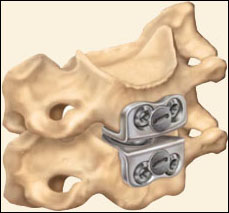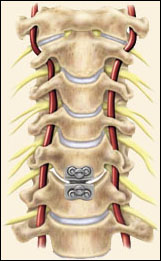Cervical Disc Arthroplasty
Cervical artificial disc replacement surgery is a joint replacement procedure that involves inserting an artificial disc, such as the PRESTIGE® Cervical Disc, between the vertebrae to replace a natural spinal disc after it has been removed. This prosthetic device is designed to maintain motion in the treated vertebral segment.
What Is Cervical Artificial Disc Surgery?
Cervical artificial disc surgery is a type of joint replacement procedure, or arthroplasty, which involves inserting a cervical artificial disc into the intervertebral space after a natural cervical disc has been removed.
A cervical artificial disc is a prosthetic device designed to maintain motion in the treated vertebral segment. A cervical artificial disc essentially functions like a joint, allowing for flexion, extension, side bending and rotation. The PRESTIGE® Cervical Disc is the first artificial disc to be approved by the U.S. Food and Drug Administration for use in the cervical spine.
Why Do I Need This Procedure?
The intervertebral discs of the cervical spine are very important for the normal mobility and function of your neck. When healthy, they act as “cushions” for the individual bones of the spine, or vertebrae. Each disc is made up of two parts
- The nucleus pulposus – the soft, gel-like center of the disc
- The annulus fibrosis – strong, fibrous outer ring that surrounds and supports the nucleus pulposus

Over time, discs can become dried out, compressed or otherwise damaged, due to age, genetics and everyday wear-and-tear. When this happens, the nucleus pulposus may push through the annulus fibrosis. Disc degeneration also may result in bone spurs, also called osteophytes. If disc or bone material pushes into or impinges on a nearby nerve root and/or the spinal cord, it may result in pain, numbness, weakness, muscle spasms and loss of coordination, both at the site of the damage and elsewhere in the body, since most the nerves for rest of the body (e.g., arms, chest, abdomen and legs) pass from the brain through the neck. Similar symptoms, however, may occur suddenly if the disc nucleus dislodges acutely and causes nerve root compression, a condition referred to as a herniated disc.
When non-surgical therapies fail to provide relief from your symptoms, your doctor may recommend spine surgery. The goal of cervical artificial disc surgery is to remove all or part of a damaged cervical disc (discectomy), relieve pressure on the nerves and/or spinal cord (decompression) and to restore spinal stability and alignment after the disc has been removed.
A spinal fusion with an anterior cervical plate currently is a very good surgical option for many patients, leaving most symptom-free and able to return to their normal activities within a short period of time. Using bone grafts and instrumentation, such as metal plates and screws, this procedure fuses, or creates a bond between, two or more adjacent cervical vertebrae, ideally stabilizing the segment and providing relief.
Cervical artificial disc replacement surgery, also referred to as spinal arthroplasty or just disc replacement, is another potential treatment option for patients with this condition.
Cervical artificial disc replacement surgery may be an appropriate treatment option for you if:
- You have been diagnosed with cervical radiculopathy, myelopathy or both with the presence of disc herniation and/or bone spurs
- Your symptoms did not improve after conservative treatment measures, such as exercise, pain relievers, physical therapy and/or chiropractic care
- You require treatment at only one cervical level
- You are at least 18 years of age with skeletal maturity
- Are not pregnant or nursing at the time of surgery
To determine whether cervical artificial disc replacement surgery is the right treatment for you, your physician will perform a physical exam and other diagnostic testing, such as a spinal X-ray; magnetic resonance imaging (MRI), computed tomography (CT) scan, myelogram and/or a bone scan.
It is important that you discuss the potential risks, complications, and benefits of cervical artificial disc replacement surgery with your doctor prior to receiving treatment, and that you rely on your physician's judgment. Only your doctor can determine whether you are a suitable candidate for this treatment.
How Is Cervical Artificial Disc Replacement Surgery Performed?
Through a small incision made near the front of your neck (a surgical approach called the anterior approach) your surgeon will:
- Gently pull aside the soft tissues – skin, fat and muscle – as well as the trachea, or windpipe, to access the cervical spine
- Expose the area where disc fragments and/or bone spurs are pressing against the neural structures (nerve roots and/or spinal cord)
- Remove the disc and bone material from around the neural structures to give them more space (discectomy and decompression)
- Insert and secure the artificial disc into the intervertebral space, using specialized instruments
- Ease the soft tissues of the neck and other structures back into place and
- Close the incision
Knowing what to expect during your procedure can help you face your surgery with confidence. Your doctor can give you additional details about the procedure specific to your condition.
How Long Will It Take Me To Recover?
Your surgeon will have a specific post-operative recovery plan to help you return to your normal activity level as soon as possible. Your length of stay in the hospital will depend on your treatment and physical condition. You typically will be up and walking by the end of the first day after the surgery. Your return to work will depend on how well your body is healing and the type of work/activity level you plan to return to.
Work closely with your spinal surgeon to determine the appropriate recovery protocol for you, and follow his or her instructions exactly to optimize your healing process.
Are There Any Potential Risks Or Complications?
As with any spine surgery, surgical treatment with the PRESTIGE® Cervical Disc is not without risk. A variety of complications may occur, either alone or in combination.
Potential risks associated with any surgery include anesthesia complications, blood clots, allergic reactions and adverse effects due to undiagnosed medical problems, such as silent heart disease. Potential complications associated with spine surgery and the PRESTIGE® Cervical Disc may include

- Implant failure
- Infections
- Neck and/or arm pain
- Difficulty swallowing
- Voice Hoarseness
- Nerve or spinal cord injury, possibly causing
impairment or paralysis
- Development or progression of disease at other
cervical levels
- Bleeding or collection of clotted blood
(hematoma)
- Reactions to anesthesia
There is also the risk that this surgical procedure will not be effective, and may not relieve or may cause worsening of preoperative symptoms.
Prior to treatment, please discuss the risks associated with cervical artificial disc surgery thoroughly with your doctor.
It is important that you discuss the potential risks, complications and benefits of the PRESTIGE® Cervical Disc with your doctor prior to receiving treatment, and that you rely on your doctor’s judgment. Only your doctor can determine whether you are a suitable candidate for this treatment.
 Important Safety Information Important Safety Information |


